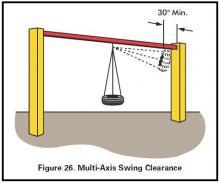
Swing safety is a very complex issue. There are three different types of swings, placement requirements, use zone requirements, requirements for the type of fasteners and suspending elements, and surfacing requirements that must all be taken into consideration.
The different types of swings include single axis or to-fro swings, multi axis swings, such as tire swings, and combination swings. Combination swings are a new style of swing for the U.S. They have been used in Europe for some time. The swings are designed for two people to use at a time.
Swing safety is an important issue in the field of playground safety. According to the NEISS database of May 2009, 22% of recorded injuries were associated with swings.1
Playground owners are cautioned to place swing sets along the perimeter of a playground away from other equipment to minimize children from going into the path of a moving swing. Fences and shrubbery can be used to define a swing’s use zone.2 Swings may not be attached to a composite structure.3
Use zones for swings depend on the type of swing. Diagrams of use zones for single axis and multi axis swings can be found in the U.S. Consumer Product Safety Commission’s (CPSC) “Public Playground Safety Handbook.”4 To-Fro belts and partially enclosed tot seat swings require a use zone in front and back of the swings that is twice the distance of the height from the pivot point to the surface. For example, if a swing top rail is 8’ high, the use zone should be 16’ in front and in back of the swings. On the side of the swings, a use zone of 6’ from the edge of the frame is required. The same use zone is required for partially enclosed tot seats and accessible seats. Totally enclosed tot seat swings require a use zone that is twice the distance from the pivot point to the bottom of the swing seat.
A diagram for single axis swing spacing is included in the CPSC “Public Playground Safety Handbook.”5 This is the distance between swing seats, between seats and the frame, and between the swing hangers.
Tire swings require a use zone that is equal to the length of the chains suspending the tire plus 6’. When the seat is extended, it can come no closer than 30” to the swing frame. The ends of the frame require 6’ of clear use zone space.6
The use zone for combination swings is composed of elements from both single axis and multi axis swings. A diagram of a combination swing use zone can be found in ASTM F1487-11.7
No more than two single occupancy swings or one multiple occupancy swing can be suspended in a single bay. Enclosed tot seats should be suspended in their own bay.8 Swings should be suspended with chain. Ropes are not recommended to be used to suspend swings.9
Connecting devices or fasteners, such as “S” hooks, must be closed so there is no gap bigger than .04”. The complete requirements for “S” hooks are found in ASTM F1487-11, Section 6.4.5.10 “O” rings are not recommended. Clevises can be substituted for “S” hooks.
The surfacing requirements for swings depend on the height of the pivot point. The depth of the surface should be adequate for a critical height the same as the height of the pivot point above the protective surface. The surface manufacturer’s test data can confirm the depth needed to match the critical fall height requirements.
To avoid the possibility of hardware failure, hardware should be replaced as soon as wear begins to be visible. Swings that are worn and show their metal core should also be replaced. The edges of swings should be smooth and rounded, and there should be no protrusions on the swings.11
- 1. “Injuries.” National Program for Playground Safety. < http://www.playgroundsafety.org/research/injuries > 26 April 2012.
- 2. “Public Playground Safety Handbook.” U.S. Consumer Product Safety Commission (CPSC), Publication 325-10, 5.3.8.1, p. 38.
- 3. Ibid, “Public Playground Safety Handbook.” 5.3.8.3.1. p. 39.
- 4. Ibid, “Public Playground Safety Handbook.” Figures 25 and 27, p. 40.
- 5. Ibid, “Public Playground Safety Handbook.” Figure 23, p. 38.
- 6. Ibid, “Public Playground Safety Handbook.” Figures 26 and 27, p. 40.
- 7. “Standard Consumer Safety Performance Specification for Playground Equipment for Public Use.” ASTM International (ASTM) Standard F1487-11, Figure A1.58, p. 65.
- 8. Op. cit., “Public Playground Safety Handbook.” 5.3.8.2, p. 39.
- 9. Op. cit., “Public Playground Safety Handbook.” 5.3.8.1, p. 38.
- 10. Op. cit., ASTM, 6.4.5, p. 6.
- 11. Op. cit., “Public Playground Safety Handbook.” 5.3.8.3.1, p. 39.

